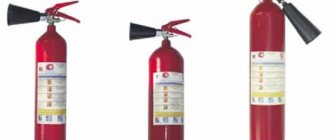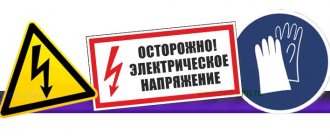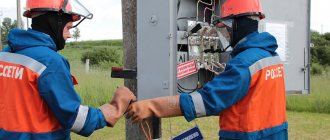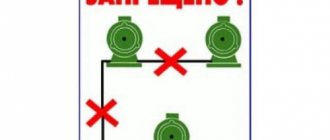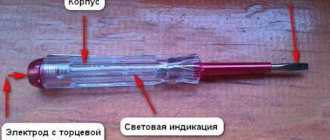Eliminating fires in houses or special-purpose technological facilities requires compliance with certain fire safety measures and rules. Failure to follow these rules may result in a serious fire hazard.
The most common causes of fire:
- defects in wiring and electrical equipment;
- improper use of electrical appliances.
Operational action plan in case of electrical installation fire
In the event of a fire, it is important that employees do not panic and follow all established safety rules. Specialists are trained in fire extinguishing methods in courses.
The emergency procedures and procedures are as follows:
- the employee who noticed the ignition is obliged to report this to management;
- the shift supervisor informs the fire services and all employees of the enterprise;
- then evacuation is carried out and the automatic fire extinguishing system is turned on;
- the shift supervisor meets the rescuers and escorts them to the fire site;
- At the request of the fire service, the electricity is turned off.
Attention! The technological document “Tactics for extinguishing electrical installations under voltage” must be located in an accessible place at the enterprise so that all employees can read the instructions. possible on our website. The network also offers videos of fire extinguishing on electrical installations.
Table - Permissible distances from electrical installations to fire nozzle nozzles.
| Electrical installation voltage, kV | Distance from the fire nozzle nozzle to the burning electrical installation and cable, m |
| up to 1 | 4 |
| 1–10 | 6 |
| 10–35 | 8 |
| 35–110 | 10 |
By the way. Electrical appliances can ignite at enterprises of various types (mechanical engineering, metallurgy, boiler houses). Inventory and equipment stored in these organizations are often explosive.
Requirements for fire extinguishers
Any fire extinguisher must be supplied with a passport from the manufacturer and a serial number according to the accounting system of the operating organization. The trigger mechanism is equipped with a protective seal, which is installed by the verification company or the manufacturer.
Also read: Power Transformer Maintenance and Repair
The enterprise must organize control over the serviceable condition of fire extinguishers and their timely checking and recharging. The specified fire extinguishing means must be placed in convenient places, in close proximity to the place of possible use, located at a height of 1.5 m from the floor level.
According to government regulations, fire extinguishers must meet the following requirements:
- allow their use by one person with the ability to process the area, according to the technical specifications from the manufacturer;
- exclude the occurrence of danger to humans during use;
- have the necessary strength to ensure safety of use.
The distance of fire extinguishers from a possible source of fire is from 20 to 70 m, depending on the class of the room in terms of explosion and fire hazard.
Primary fire extinguishing agents
If the installation is under electrical voltage, the initial fire extinguishing at the substation is carried out with carbon dioxide fire extinguishers filled with fire extinguishing agent. The carbon dioxide contained in the cylinders does not allow current to pass through. When the device is triggered, it is converted into carbon dioxide.
The latter cools the heated object and reduces the amount of O2. Without oxygen, combustion stops.
The requirements for extinguishing electrical installations and production equipment state that fire extinguishing must be carried out by two people. One is responsible for supporting the socket, and the second opens the valve.
Extinguishing electrical installations under voltage is also carried out using:
- hard sand – for wires, cables or flammable liquids;
- felt or asbestos fiber.
Nuances of extinguishing electrical installations
The difficulty of working with live electrical installations lies in the additional dangerous factors at the emergency site.
- The presence of lubricant as an additional medium for the spread of fire.
- The turbine generators are located at a distance of 8-10 m from the floor, which makes it difficult for firefighters to approach the fire source.
- The presence of insulating materials that, when melted, become a source of smoke.
- Location of a large number of installations and distribution areas in one place.
- The need to remove voltage from the electrical installation, which increases the time for organizing direct extinguishing.
When the point receives a signal about a fire in the area of operation of an electrical installation under voltage, the RTP gives an order to de-energize the equipment and ground it. If possible, the enterprise workers install thermal insulation in adjacent areas to protect against fire. Measures must be taken to remove oil as a favorable environment for the spread of flame. For protection, a barrier of sand is set up. Rescuers arriving at the scene of a fire move from the edge of the site to its middle, gradually cutting off the flames from installations not affected by the fire.
Features of extinguishing electrical equipment
The choice of means for extinguishing fires in live installations must take into account the characteristics of the fire.
In more detail, you can read the recommendations for extinguishing energized electrical installations.
Wiring
Ignition of electrical wiring often occurs due to a short circuit in the network. In the absence of voltage, fire-fighting actions can be performed with a regular water fire extinguisher, but the use of foam is prohibited.
Attention! If the wires are live and this cannot be changed, powder is sprayed to extinguish.
Electrical installations
Electrical equipment with what maximum voltage can be extinguished with a carbon dioxide fire extinguisher? Instructions for extinguishing fires in electrical installations state that extinguishing fires in energized equipment is carried out taking into account the power of the electrical network to which it is connected.
Up to 0.4 kV
Extinguishing ignited electrical installations under a rated voltage of up to 0.4 kilovolts is carried out taking into account the following rules and recommendations:
- freon fire extinguishers are used;
- It is prohibited to use compact jets;
- the distance from the hose to the flame is 5–6 meters;
- specialists work in dielectric workwear.
Over 0.4 kV
The best option for extinguishing a fire in an installation that is under voltage greater than 0.4 kV is powder. The length of the powder jet should be 1–2 meters so that the person extinguishing the fire is not injured.
Electrical control room
Fires in installations under voltage up to 10 kV are extinguished using carbon dioxide fire extinguishers.
Due to health risks, the following requirements must be observed:
- air humidity norm – 0.0006%;
- The minimum distance from the hose to the source of fire is 3–4 meters.
Tactics for extinguishing electrical installations under voltage by fire departments
When performing a combat deployment, it is necessary to follow a certain sequence of actions to ensure safe conditions for firefighters supplying fire extinguishing agents to live parts of electrical installations. Therefore, upon arrival at the place of call, the combat crew of the fire department performs the following work:
- the chief of guard determines the deployment of forces and means based on the situation during the fire, agreed with the on-duty personnel of the power facility;
- Firefighter No. 1 grounds the manual fire barrel, connecting it using special clamps and wires to a stationary grounding circuit in the specified location, and then goes to the combat position determined by the guard chief;
- fireman No. 2, together with fireman No. 3, lays a hose line from the tanker to the combat position of fireman No. 1 along the route indicated by the guard chief;
- The driver of the fire truck, together with firefighter No. 4, grounds the pump using special clamps and wires by connecting at the indicated location to a stationary ground loop or grounded structures.
After extinguishing the fire, all work must be performed in the reverse order:
- the supply of fire extinguishing agents is stopped;
- the clamps are disconnected from the grounding loop and grounding devices;
- firefighters leave combat positions along safe routes and remove fire-fighting equipment into vehicle compartments.
In addition to the general features of extinguishing energized electrical installations, there are also recommendations for extinguishing specific types of equipment, such as electrical panels and electrical wiring. In any case, if a fire is detected, it is necessary to notify the fire department as soon as possible and, if possible, turn off the power to the facility.
Extinguishing electrical panels
As a general rule, extinguishing an electrical panel begins after the system is de-energized - in this case, it is allowed to use any type of fire extinguisher, as well as available means (soil, sand, any dense natural material). If de-energizing is impossible, powder, carbon dioxide and halon fire extinguishers are used.
When extinguishing, it is necessary to observe safety precautions: use dielectric gloves and boots, as well as respiratory protection. It should also be remembered that when using powder fire extinguishers there is a risk of damage to the equipment (the powder forms a film that is difficult to remove), and carbon dioxide fire extinguishers produce a jet of very low temperature, so additional hand protection will be required.
Industrial electrical control rooms are usually located at a distance from production buildings, as a result of which a fire cannot be detected immediately. For this reason, such facilities are often equipped with automatic fire extinguishing systems, which allow a fire to be quickly identified and eliminated.
Extinguishing electrical wiring
The main causes of electrical fires are technical failure, improper operation or design.
Insulation material can melt, dry out and wear out under the influence of external factors and time. As a result, the wires are exposed, and this leads to short circuits, which cause electrical fires.
A situation often arises when an extension cord with several sockets is connected to one of the sockets, sometimes also additional splitters - and as a result, the load on 1 socket becomes too large, which causes overheating of the network, overloads and sparking, and ultimately causes a fire.
To extinguish electrical wiring after a power outage, any fire extinguishing means may be used. If it is not possible to turn off the current, powder and gas fire extinguishing agents are used. When using them, you should remember safety precautions: maintain a safe distance and do not inhale toxic fumes.
Security measures
Extinguishing electrically energized devices will be more successful if the following safety rules are observed:
- the voltage is turned off before fire extinguishing work begins (if this is possible);
- two rescuers are involved in extinguishing the fire, the remaining people must leave the room to reduce the risk of electric shock;
- all fire department employees must wear protective clothing (insulator gloves and boots);
- a water jet is not used to extinguish fires in energized appliances;
- All fire-fighting operations are carried out by representatives of the Ministry of Emergency Situations with the permission of the administration and the admission of the fire safety chief.
Safety precautions when extinguishing
Precautions:
- the combination of materials is taken into account, and the fire extinguishing agent is selected for it (for example, an electrical installation burns together with fuel and lubricants);
- When using gas fire extinguishers you will need:
- personal protection in confined spaces;
evacuation of personnel before processing begins;
- will increase the effectiveness of closing ventilation and the tightness of the room;
- Non-conductive clothing (rubber galoshes, gloves) is highly recommended;
- spray jets are used;
- foam treatment occurs by filling the space around the electrical installation;
- aqueous extinguishing agents are prohibited for highly heated, molten, or reacting materials;
- the bell, nozzle, nozzle must be non-conductive. But dielectric elements are prohibited with static charges for sensitive objects (clauses 4.1.11 - 4.1.13 SP 9.13130).
- It is not allowed to bring the socket closer than indicated by the airbag and TD of the device.
Prevention of fires in production
The occurrence of fire in enterprises is practically impossible to prevent, however, compliance with fire safety measures and a responsible attitude to the operating rules of installations can reduce the risk of fires significantly:
- employees must undergo fire safety training and know what measures to take first when a fire occurs;
- it is necessary to carry out timely scheduled preventive inspections of electrical installations;
- to reduce voltage fluctuations, management needs to take care of installing automatic regulators;
- To prevent the network from being overloaded, electrical machines are used to cool the equipment.
Eliminating fires at power plants is a complex process that requires thorough training of personnel and rescuers, and careful attention to all actions taken. However, it is always better to prevent a fire than to put it out, so preventive measures should become mandatory for the enterprise.
To extinguish fires of this type, a permit to extinguish fires in electrical installations is required.
Detailed information is visible in the video:
Automatic systems for extinguishing fires in electrical installations under voltage
Extinguishing electrical installations, especially in cases where it is not possible to de-energize the facility, is a difficult task, and it is best to entrust its implementation to professionals.
But as you know, prevention is better than dealing with the consequences. Proper design and operation of electrical equipment, along with the installation of an automatic fire extinguishing system, can reduce the risk of fires and serious damage to a minimum. In addition, the process of extinguishing live electrical installations using an automatic system becomes fast and safe for both people, equipment, and the facility as a whole.
With the help of automatic gas fire extinguishing systems (i.e. systems in which extinguishing occurs using fire extinguishing agents - gaseous fire extinguishing agents), two most important tasks of eliminating fires in electrical installations are solved at once:
- rapid detection, localization and suppression of fires;
- the ability to extinguish equipment without turning off the electric current.
Gas extinguishing agents do not conduct electricity and do not react with the materials from which electrical equipment is made, so their use does not cause harm to operating electronics.
Modular gas fire extinguishing systems, in contrast to modular installations with a pipeline, have other advantages:
- Easy to install and operate. Installing the module does not require large-scale work - it is simply mounted on the bracket supplied in the kit. In addition, modular installations require several times less cost and attention during operation.
- Compactness. In conditions where a fire extinguishing system needs to be installed in a limited space (for example, in a small electrical room), every centimeter of usable space matters. MGP “ZARYA” are compact and can be installed both on walls and on the ceiling.
- Mobility. The module can be removed and moved to another room, and no labor-intensive installation or repair work will be required. This is relevant for objects such as server or cross-connection.
You can get detailed advice on the use of modular gas fire extinguishing systems to protect electrical installations from fires from ISP company employees - contact us through the contact form on the website or by phone.
